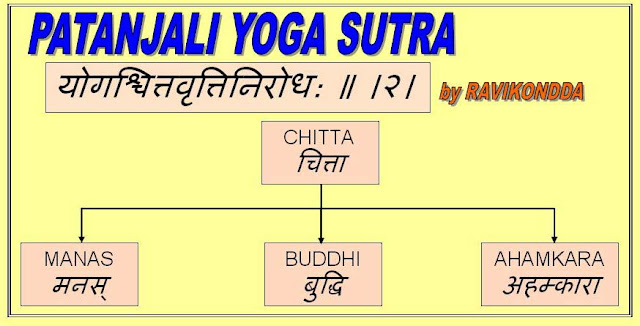Patanjali Yoga Sutra – Chapter-1 – verse-2 :- |
योगश्चित्तवृत्तिनिरोध: ॥ ।२। |
”Yoga is the control of thought waves in mind”. But actually the meaning for the word निरोध: nirodhaha according to dictionary is Prevention, suppression. So it should actually be Prevention or suppression of thought waves in the mind. |
According to Pathanjali the mind चित्ता ‘chitta’ is made up of three components namely मनस् ‘manas’, बुद्धि ‘buddhi’ and अहम्कारा ‘ahamkaara’. |
1. Manas मनस् receives information gathered by the senses from environment and stores it. 2. Buddhi बुद्धि discriminates and classifies these information and reacts. 3. Ahamkara अहम्कारा is the ego-sense which owns these information and stores them as individual knowledge. |
आत्मन् - According to the Upanishads and the Bhagavad Gita, Atman is present within all creatures. Patanjali who was a follower of Sankya philosophy, believed in this statement. |
(But according to Advaita philosophy, there is no duality and hence, Atman itself is Purusha the Supreme God in all living creatures.) |
Knowledge or perception is a thought wave वृत्ति in the mind चित्ता. According to Patanjali mind is not the seer, but only an instrument of knowledge. The Atman is the real seer. |
Every perception arouses the अहम्कारा ego-sense, which says, “I have done this…… I know this….. etc., But this is the ego speaking and not the Atman. The ego sense is caused by the identification of the Atman with the mind and senses…… etc., |
If something is perceived by the senses, a thought wave is created in the mind. The अहम्कारा ego-sense identifies itself with this wave. If the wave is pleasant the अहम्कारा ego-sense feels “I am happy”, and if the wave is unpleasent “I am unhappy”. |
“This false identification is the cause of all our misery”. |
Thus अहम्कारा ego-sense’s temporary sensation of happiness brings anxiety, and also a desire to cling to the object of pleasure. But at the same time, prepares future possibilities of becoming unhappy, when desired object of pleasure is not got. |
The real self – आत्मन् Atman remains forever outside the power of thought waves. It is eternally pure, enlightened and free. The ever unchanging happiness or “Bliss” referred to as आनन्दा ‘Ananda’ by the Upanishads. |
So one can never know the आत्मन् real self as long as the चित्ता ‘chitta’ and the अहम्कारा ego-sense are identified. |
So to become enlightened one mush bring the चित्ता ‘chitta’ thought waves under control, prevent, suppress. निरोध: |
For an anology we can take the lake. When there are no waves, the bottom of the lake can be seen clearly, the bottom being Atman. |
Type of mind differs from person to person. Many minds are not yet ready for the higher Yoga practices. Some minds can be described as “scattered”. They are restless, passionate, and unable to concentrate. They are lazy, inert minds, incapable of constructive thoughts. Then there are some energetic minds which can dwell only in pleasure and tries to run away from unpleasent things. |
According to Pathanjali – Every mind no matter what its present nature be, can ultimately be disciplined and transformed to become “one pointed” and fit to attain the state of perfect Yoga |


No comments:
Post a Comment